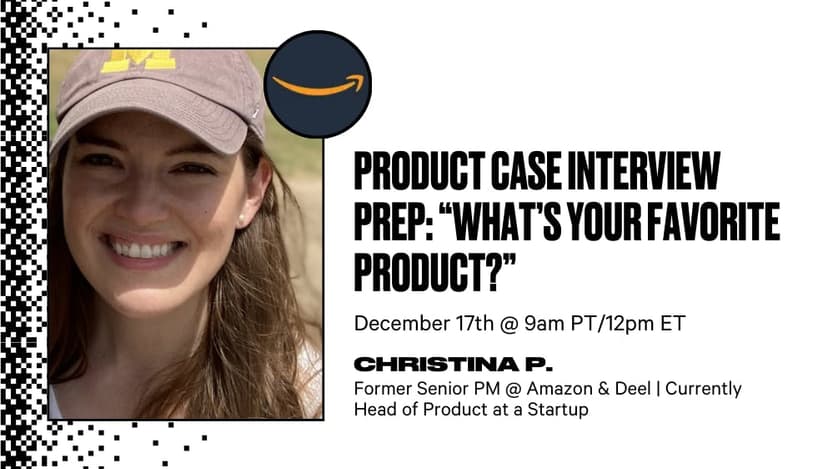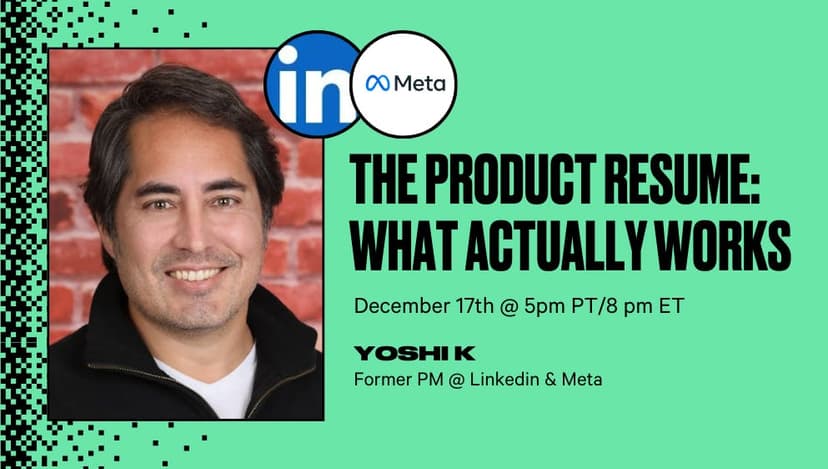FAANG Product Manager Resume Guide [With Example & Template] (2025)
Learn how to craft a standout product manager resume for FAANG with examples, templates, and tips that highlight real impact.
Posted September 12, 2025

Join a free event
Learn from top coaches and industry experts in live, interactive sessions you can join for free.
Table of Contents
Landing a product management role at a FAANG company isn’t just about having strong experience; it’s about how well you communicate that experience on paper. Recruiters and hiring managers spend seconds scanning resumes, and most never make it past the applicant tracking system (ATS). The difference between a good product manager resume and a great one often comes down to clarity, impact, and tailoring.
This guide will walk you through exactly how to craft a FAANG-ready product manager resume. You’ll learn what recruiters look for, how to structure each section, and how to transform generic responsibilities into impact-driven achievements. We’ll share before-and-after examples, downloadable templates, and real-world recruiter insights so you know precisely how to stand out, whether you’re an aspiring associate PM, an experienced technical product manager, or a senior leader aiming for director-level roles.
What Recruiters Look for in a Product Manager Resume
When a hiring manager (especially in FAANG) glances at your product manager resume, they are doing so under time pressure. In many cases, recruiters spend only 6–10 seconds scanning a resume initially. To beat that, your resume must show:
- Impact on responsibilities: measurable outcomes. Don’t list duties, show results — user growth, revenue growth, customer retention, cost reduction.
- Evidence of cross‑functional leadership: managing engineering team, design, marketing; stakeholder management; working across product strategy, product development process.
- Communication clarity: clean, sharp wording, no filler jargon like “strategic thinker” unless you back it up. Reddit threads repeatedly roast resumes for “buzzword stuffing” and wordy‑weak bullets.
Real-world insight from recruiters: “When looking at a product manager's resume, I'm expecting a very well-structured, crisp, and sharp-worded resume. Mentioning key achievements in numbers.”
Also helpful:
- A recruiter wants to know: How many years of product management experience, what your proven track record is, and whether you’ve led in senior or cross‑functional roles.
- Understand what format and design help pass through applicant tracking systems (ATS): clean layout, minimal graphics, readable fonts, and keywords from the job description.
How to Structure a Product Manager Resume
A great product manager resume doesn’t just look clean; it’s structured to speak to both humans and hiring algorithms. Recruiters need to skim and spot impact fast, while applicant tracking systems (ATS) need to parse your resume accurately to rank you for a role.
Here’s the expert-backed structure you should follow:
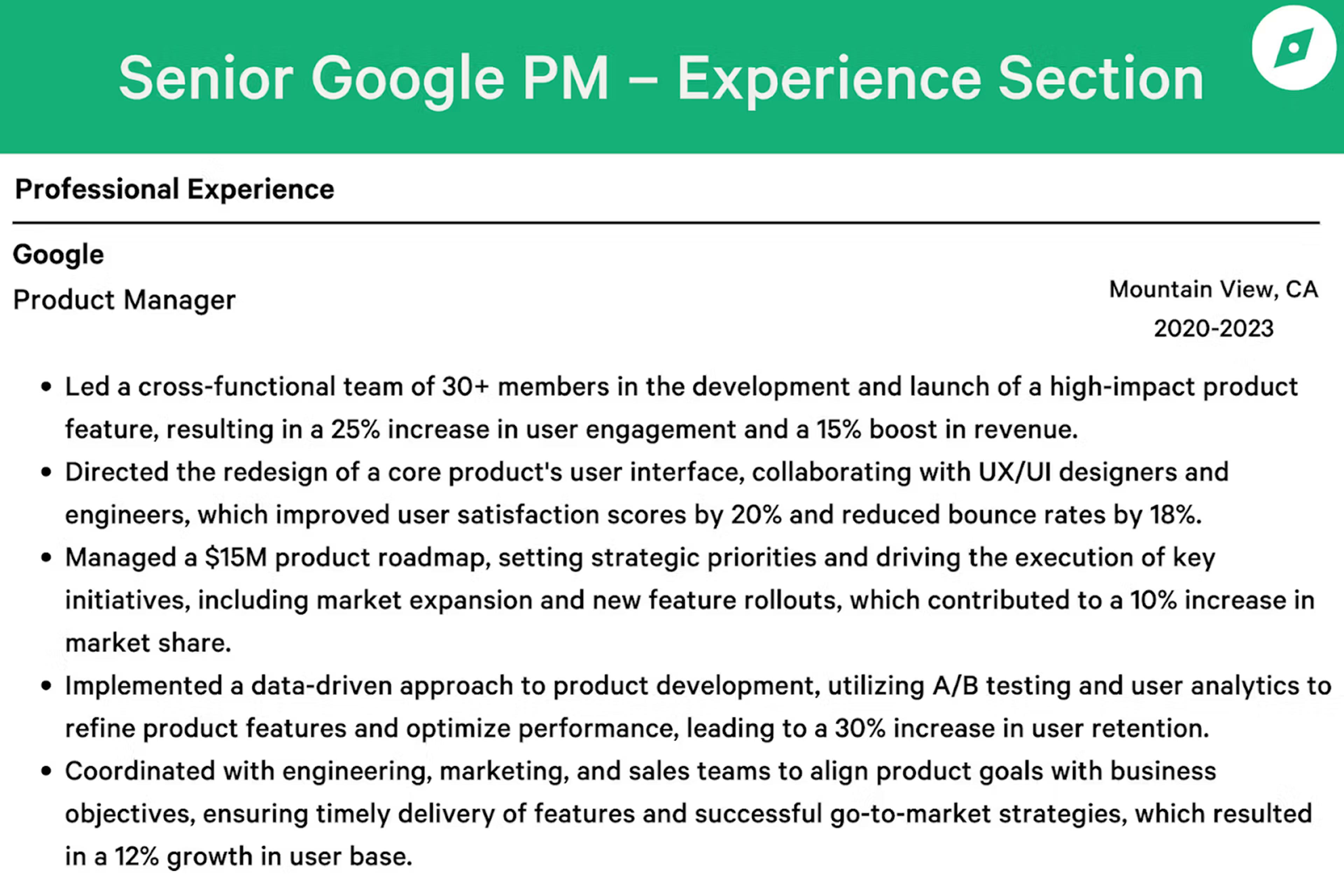
Format: Reverse Chronological Order
This is the gold standard, and what most recruiters expect. List your most recent and relevant roles first. Show progression, scope, and outcomes over time.
If you’re creating a senior product manager resume or technical product manager resume, 2 pages are acceptable — but your first page must deliver the most impact.
For entry-level product manager or associate product manager resumes, keep it to 1 page. Focus on transferable skills, relevant projects, and data-backed outcomes.
Page length rules (by experience level):
| Level | Recommended Length |
|---|---|
| Entry / Associate PM | 1 page |
| Mid-level PM | 1–2 pages |
| Senior / Lead PM | 2 pages (only if needed) |
If you go to two pages, ensure every bullet is high-value and relevant to the specific product manager job you’re targeting.
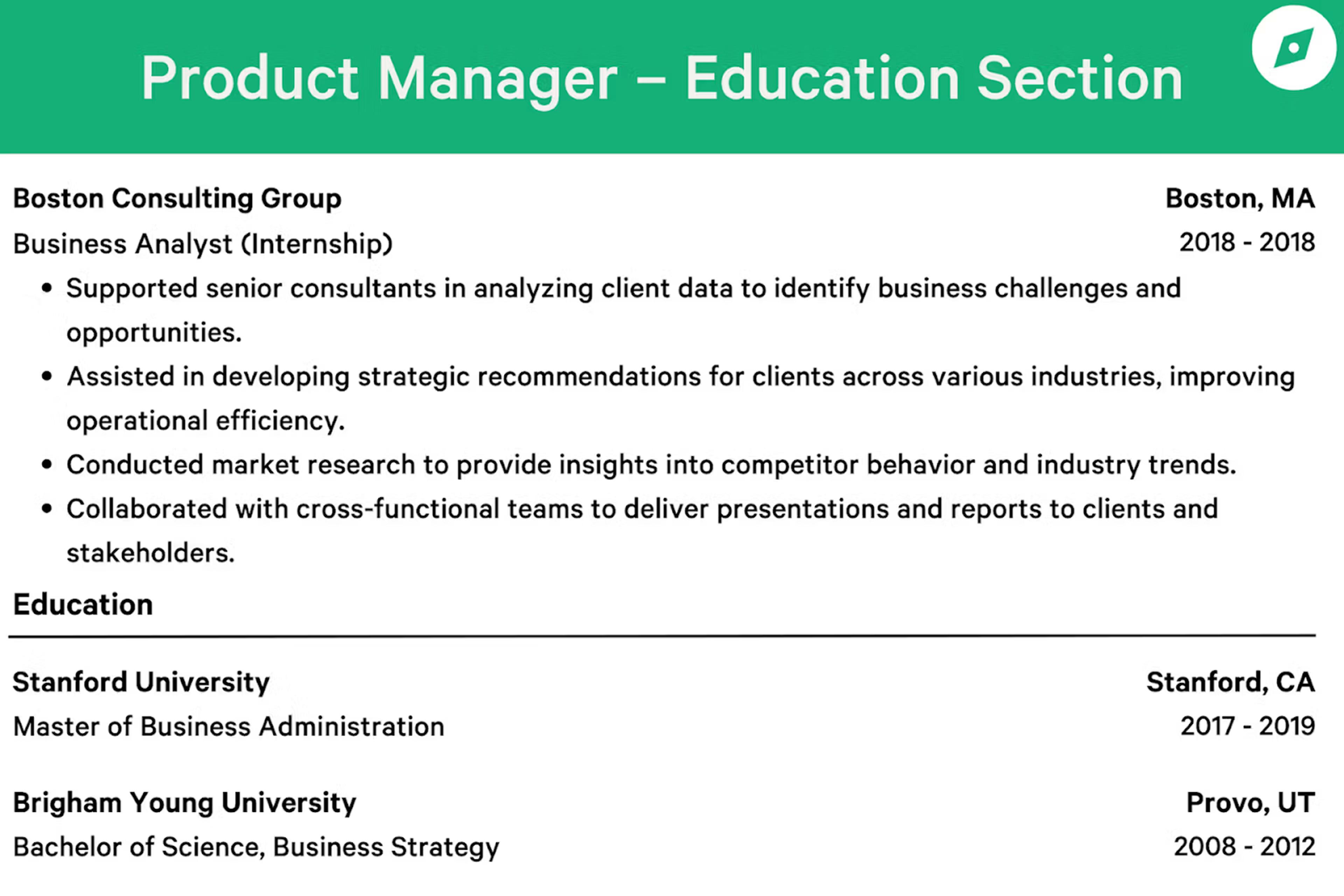
Layout & Visual Clarity
- Stick to a single-column layout — it’s easier for ATS to parse and for humans to skim.
- Use consistent formatting: aligned headings, equal spacing, uniform bullet points.
- Avoid visuals, icons, graphs, and tables that might confuse parsing software.
- Use clean, modern fonts like Arial, Calibri, or Helvetica Neue.
Recruiter Tip: “Your resume should look like a clean product spec. Clear, concise, no clutter, and the impact should be obvious at a glance.” — FAANG Recruiter via Quora
ATS Compatibility Essentials
- Save as .docx or PDF (only if you know it’s ATS-safe).
- Avoid headers/footers, text boxes, or multi-column sections.
- Use keywords from the job description — especially related to product strategy, cross-functional teams, technical skills, and product management frameworks.
- Include relevant skills for your niche (e.g., agile project management, market research, stakeholder management, A/B testing, data analysis).
Diagram or wireframe suggestion:
Use a labeled visual showing the ideal structure:
Header
→ Summary
→ Key Skills
→ Experience
→ Education & Certifications
→ Relevant Projects / Publications (optional)
Transform your resume into a recruiter magnet by downloading this expert-approved Product Manager resume template, and start landing interviews today!
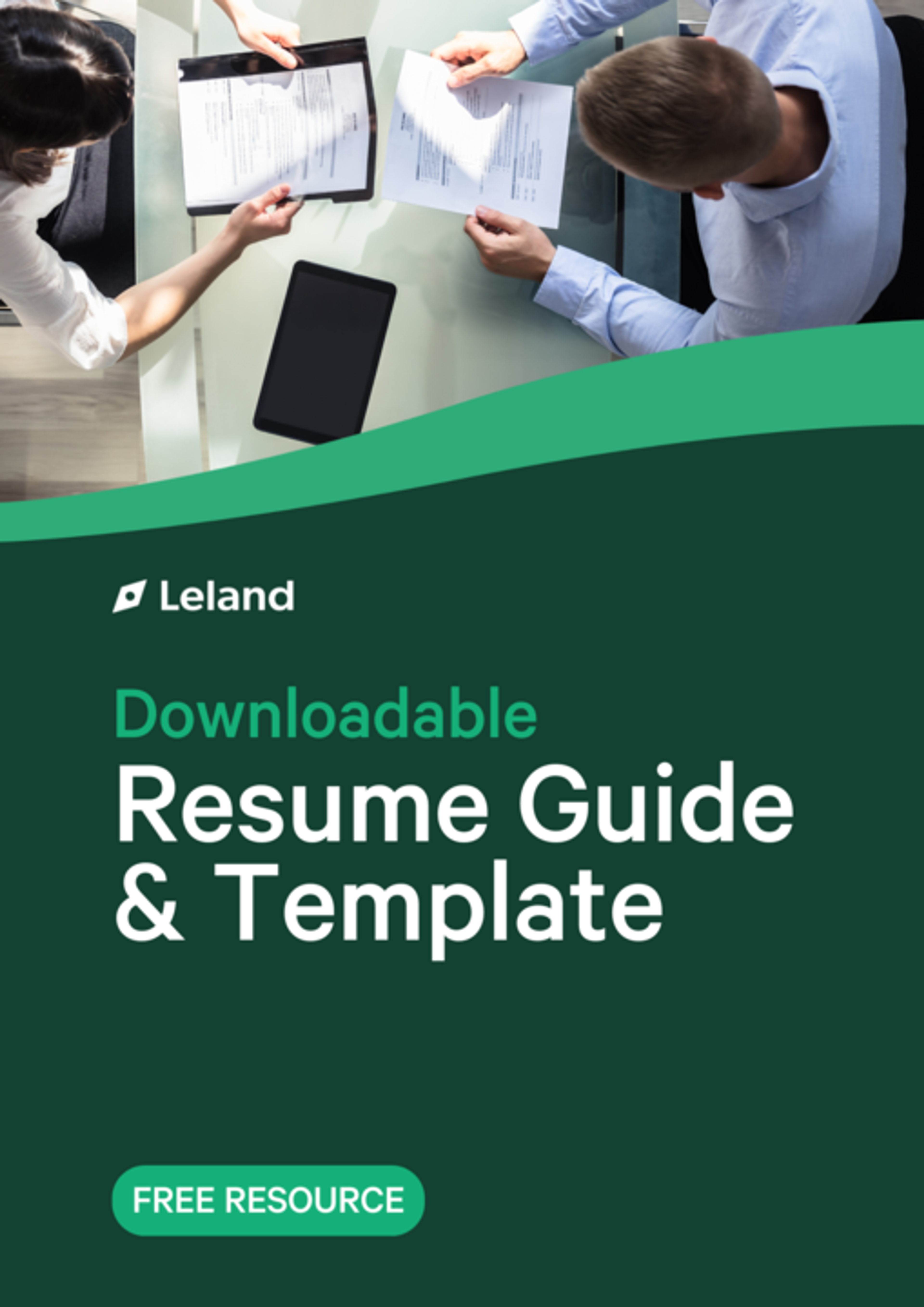
Downloadable Resume Guide & Template
A free, expert-created resume guide to help you write the most compelling product resumes
Key Sections of a Product Manager Resume (With Examples)
Below are the core sections of a compelling product management resume, with examples of good vs weak content.
| Section | What to Include | After (Strong Example) | Before (Weak Example) |
|---|---|---|---|
| Header & Summary | Your name, contact info, LinkedIn/GitHub, target role (optional: product strategy, technical focus). In summary: years of experience, your specialization, one or two big outcomes. | “Senior Product Manager with 7 years in technical product management, driving revenue growth of $25M+; led cross-functional teams to scale user base by 3× across mobile & web.” | “Experienced product leader passionate about innovation and strategy.” |
| Experience | Use the “Impact Formula”: action verb + skill + measurable outcome. Focus on direct product management experience. Include scope (team size, scale, budget), especially for senior roles. | “Managed engineering team of 8, driving roadmap for mobile app feature that increased user engagement by 40% and reduced churn by 25% in 6 months.” | “Responsible for product roadmap and features; collaborated with cross-functional teams.” |
| Skills | Balance technical skills (SQL, A/B testing, Agile methodologies, data analysis) and soft skills (leadership, stakeholder management, communication skills). | Technical Skills: SQL, Python, A/B Testing, Agile. Soft Skills: Cross-functional leadership, communication, product strategy. | “Skills: leadership, strategy, communication, problem-solving.” |
| Education & Certifications | Degrees, relevant coursework, Scrum/CSPO/PM certifications if applicable. Only emphasize strongly early in career or when switching fields. | “MBA, University X; Certified Scrum Product Owner (2023); coursework in market research & computer science fundamentals.” | Listing many unrelated certifications with no context. |
Read: How to Nail “Tell Me About a Time…” Interview Questions
Product Manager Resume Examples by Experience Level
Your resume should evolve as your career progresses. A hiring manager reading an associate product manager resume is looking for potential and transferable skills, while reviewing a senior product manager resume requires proof of vision and leadership. Below are examples, tailored by level, with metrics-driven bullets and explanations of why each approach works.
Entry-Level / Associate Product Manager Resume
At this stage, you may have no direct product management experience. What recruiters want to see is evidence of relevant skills in action — whether from school projects, internships, case competitions, or side hustles.
What to highlight:
- Relevant coursework (computer science, business administration, digital marketing).
- Transferable skills: market research, data analysis, project management, user feedback, agile methodologies.
- Side projects or internships that demonstrate ownership of the product development process.
Example bullet (weak → strong):
- Weak: “Helped with market research for app prototype.”
- Strong: “Conducted market research and competitive analysis on 5 competitors; insights influenced feature prioritization, improving prototype usability scores by 15%.”
Why This Works: Recruiters understand you may not have years of direct product management experience, but they still expect evidence of impact and initiative. By framing coursework or projects in terms of outcomes (usability improvement, growth, retention), you demonstrate relevant skills and signal that you can translate classroom or project experience into business results.
Mid-Level Product Manager Resume
Once you have 3–7 years of experience, recruiters want to see proof of ownership: that you’ve launched features, driven measurable outcomes, and coordinated cross functional teams. This is also where you start distinguishing between a generalist product manager resume and a technical product manager resume (if you’ve built a track record with data, engineering-heavy, or platform work).
What to highlight:
- Product launches and iterations you owned.
- Business results tied to those launches: revenue growth, customer retention, increased user engagement, and customer satisfaction scores.
- Your leadership role in roadmap planning, backlog management, or cross-functional execution.
Example bullet (weak → strong):
- Weak: “Worked with the engineering team to improve system performance.”
- Strong: “Partnered with engineering to migrate to microservices, improving release cycle by 30%; led roadmap planning and backlog prioritization, accelerating feature delivery for 5M+ users.”
Why This Works: At this level, hiring managers want specific examples of outcomes at scale. They care less about vague collaboration and more about whether you can drive product strategy into execution. By quantifying results (30% faster cycles, 5M+ users), you show both technical understanding and measurable business impact, critical signals for FAANG and top startups.
Senior / Director Product Manager Resume
For senior roles, your resume must demonstrate vision, strategy, and leadership. Recruiters and executives are scanning for evidence that you can:
- Define a long-term product vision aligned with business goals.
- Influence executives and stakeholders.
- Mentor other PMs or lead multiple squads.
- Deliver P&L responsibility or large-scale business impact.
What to highlight:
- Strategic initiatives: product strategy, multi-year roadmaps, product features that drive revenue growth.
- Leadership of cross-functional teams and product management at scale.
- Business outcomes like market expansion, customer satisfaction improvements, or revenue growth.
Example bullet (weak → strong):
- Weak: “Oversaw product team responsible for SaaS platform.”
- Strong: “Set three-year product vision for data product manager line, scaling platform to serve 20M MAU; led cross-functional initiatives that delivered $40M+ in new revenue and improved customer satisfaction scores by 22%.”
Why This Works: At the director level, your impact must be undeniable. Hiring managers expect evidence of vision and business leadership. By combining scale (20M MAU), financial outcomes ($40M+), and customer impact (22% higher satisfaction), you position yourself as a leader who drives growth, not just features. This balance of strategic foresight and measurable execution is what separates good resumes from world-class ones.
Pro Tip: For all levels, pair bullets with a before/after transformation (responsibility phrased weakly → impact phrased strongly). This makes the improvement obvious to readers and shows how small wording changes can unlock big credibility with hiring managers.
Common Mistakes to Avoid
- Buzzword stuffing - phrases like “strategic thinker,” “innovative leader,” “visionary” without backing. Reddit reviewers frequently call these out.
- Listing responsibilities instead of results - “Responsible for …” vs “Drove … which resulted in …”
- Overdesigning resumes, graphics, overloaded formatting, and columns - these can break Applicant Tracking Systems.
- Not tailoring resume to role description - using generic wording vs using keywords & metrics from the specific product manager job description.
- Weak or vague summary - unclear career level (senior, associate), no proven track record, no data.
Tips to Tailor Your Resume for FAANG and Startups
| Setting | What to Emphasize (with Examples) | What to De-emphasize / Alter (with Rationale) |
|---|---|---|
| FAANG (Meta, Amazon, Apple, Netflix, Google) | Emphasize scale and metrics by highlighting quantifiable outcomes at a large scale, such as “Increased user growth from 10M to 15M MAU in 12 months” or “Drove $40M revenue growth from feature launch.” Show cross-functional leadership by describing work with engineering, design, data science, and marketing, such as “Led four cross-functional teams across three continents to deliver product strategy.” Showcase technical skills that are relevant to the role, including SQL, A/B testing, data analysis, machine learning basics, or cloud platforms. Demonstrate a proven track record using data-driven decision-making and emphasize repeatable impact across multiple roles. Keep the format clear and ATS-friendly with a one-page, single-column layout and consistent bullet points. | Do not overemphasize side projects unless they directly demonstrate FAANG-level technical depth or adoption. Avoid fluff and buzzwords such as “strategic thinker” or “innovative leader” without metrics. Skip overdesigned resumes with infographics, icons, or multi-column layouts that break ATS parsing. Do not exaggerate outcomes, since FAANG recruiters fact-check rigorously, and inflated claims can raise red flags. |
| Startups (Seed through Series D) | Highlight scrappiness and versatility by showing how you wear multiple hats, for example, “Owned product roadmap while managing GTM strategy, conducted market research, and worked with engineering on MVP launch.” Emphasize speed and iteration by describing how quickly you shipped products, such as “Launched MVP in six weeks and iterated based on 200 user interviews.” Focus on customer-centric impact by showing growth, retention, and satisfaction metrics, for example, “Boosted customer satisfaction scores by 30% after redesign informed by competitive analysis and user feedback.” Showcase agility and adaptability by highlighting your use of agile methodologies, pivot stories, and ability to thrive in uncertainty. Use your resume summary to tell a story about mission alignment and why you care about solving the company’s customer needs. | Do not copy FAANG-style formality or aesthetics such as multi-page resumes, heavy jargon, or overly corporate polish, since startups value speed and authenticity. Avoid inflating metrics; if you only managed 5,000 users, state the real number, as startups appreciate honesty about scope. Do not overemphasize job titles, since startups care more about the outcomes you drove than whether you were an Associate or Senior PM. Skip generic skills lists such as “leadership skills” or “communication skills” and replace them with concrete examples tied to specific projects. |
Free Product Manager Resume Template (Downloadable)
Here’s a customizable template framework for your resume. Use it as your starting point and adapt it for your own experience:
Checklist Before Submitting:
- Header includes contact info, LinkedIn/GitHub/portfolio
- Summary includes role level (entry, senior, etc.), “product manager” (or “technical product manager”) + metrics
- Experience in reverse chronological order
- Each bullet uses the Impact Formula: Action verb + skill + measurable outcome
- Skills section balances technical + soft skills
- Education / Certifications are relevant; relevant coursework if early career
- Resume is 1 page for less than ~5 years, 1‑2 pages for more, clean format, and ATS-friendly
Ready to Build A Product Manager Resume That Gets Interviews?
If you follow these practices, focus on measurable impact, clear structure, tailoring for FAANG or startup needs, and showing cross‑functional leadership, you’ll be much more likely to move past recruiter screening and get interviews. If you need personalized feedback or a resume review from experts, Top Product Management Coaches at Leland can help you sharpen your resume even more. Browse PM coaches here. Also, check out free events for more strategic insights!
Read these next:
- Product Design Interview: What It Is, Questions, & Tips
- Product Sense Interview: What It Is, Questions, & Tips
- Product Execution Interview: What It Is, Questions, & Tips
- AI Product Manager Interviews: Questions & Tips
- Product Marketing Manager (PMM) Interview Questions & Tips
- Data Product Manager Interviews: Questions & Tips
- Associate Product Manager Interview: What to Expect & How to Ace It
- How to Get Into Product Management (An Expert's Perspective)
- Associate Product Manager (APM) Resume Guide — With Examples
- How to Become a Product Manager (For Every Career Stage)
FAQs
How do I write a product manager resume with no direct PM experience?
- Focus on transferable and relevant projects, internships, market research, conducting user feedback, side work, relevant coursework. Use bullet points that show impact (even if small scale). Highlight soft skills, technical skills, and leadership in non‑PM roles.
How does a product manager resume differ from other tech resumes?
- It emphasizes product strategy, vision, user/customer problems, cross‑functional work, product development process, metrics (user growth, customer retention), market research. Other tech resumes may focus heavily on code, engineering execution, but PM roles care more about product lifecycle, stakeholder management, and delivering value.
What’s the best way to highlight metrics on a PM resume?
- Use the Impact Formula: action verb + skill + measurable outcome. Use concrete numbers: %, growth, revenue, user count, cost savings. Tie that metric back to business goals. Be specific: timeframes, scale (number of users, budget, revenue, team size).
Should I include side projects or case studies on my PM resume?
- Yes, if you’re entry-level or transitioning. Only include those that demonstrate product skills: market research, product strategy, user feedback, and digital product development. Shape those to show relevant skills & outcomes.
How do I make my product manager resume stand out?
- Tailor your resume to the job description, use strong metrics, show leadership and cross‑functional ability, ensure readability and ATS compatibility, avoid vague buzzwords, use concise language, show specificity, and demonstrate “data-driven decision making.”
Browse hundreds of expert coaches
Leland coaches have helped thousands of people achieve their goals. A dedicated mentor can make all the difference.
